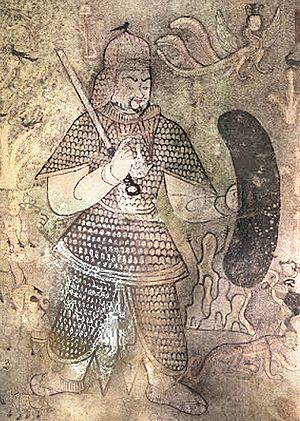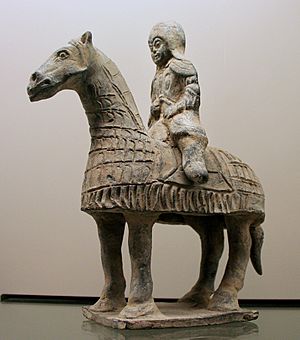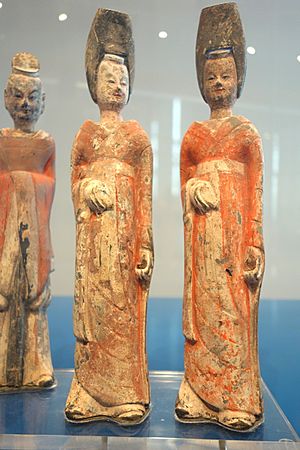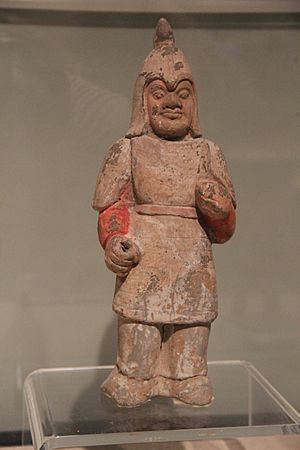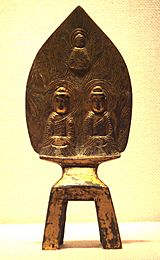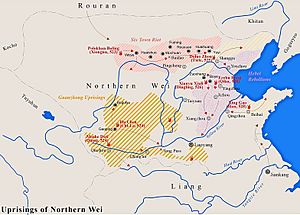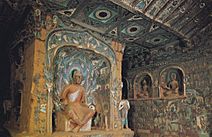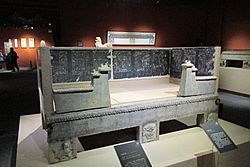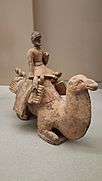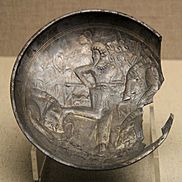Northern Wei facts for kids
Quick facts for kids
Wei
魏
|
|||||||||||||||||||
|---|---|---|---|---|---|---|---|---|---|---|---|---|---|---|---|---|---|---|---|
| 386–535 | |||||||||||||||||||
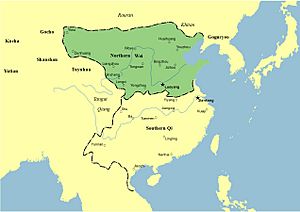
Northern Wei territory. They were bordered to the south by the Southern Qi from 479 to 502, and by the Liang from 502.
|
|||||||||||||||||||
| Capital | Shengle (386–398, capital of former Dai, near modern Hohhot) Pingcheng (398–493) Luoyang (493–534) Chang'an (534–535) |
||||||||||||||||||
| Common languages | Tuoba, Middle Chinese. | ||||||||||||||||||
| Government | Monarchy | ||||||||||||||||||
| Emperor | |||||||||||||||||||
|
• 386–409
|
Emperor Daowu | ||||||||||||||||||
|
• 409–423
|
Emperor Mingyuan | ||||||||||||||||||
|
• 424–452
|
Emperor Taiwu | ||||||||||||||||||
| History | |||||||||||||||||||
|
• Established
|
20 February 386 | ||||||||||||||||||
|
• Emperor Daowu's claim of imperial title
|
24 January 399 | ||||||||||||||||||
|
• Unification of northern China
|
439 | ||||||||||||||||||
|
• Movement of capital to Luoyang
|
25 October 493 | ||||||||||||||||||
|
• Erzhu Rong's massacre of ruling class
|
17 May 528 | ||||||||||||||||||
|
• Establishment of Eastern Wei, marking division
|
8 November 535 | ||||||||||||||||||
|
• Emperor Xiaowu's death
|
3 February 535 | ||||||||||||||||||
| Area | |||||||||||||||||||
| 450 | 2,000,000 km2 (770,000 sq mi) | ||||||||||||||||||
| Currency | Chinese coin, Chinese cash |
||||||||||||||||||
|
|||||||||||||||||||
| Today part of | China Mongolia |
||||||||||||||||||
| Northern Wei | |||||||||||||||||||
|---|---|---|---|---|---|---|---|---|---|---|---|---|---|---|---|---|---|---|---|
| Chinese | 北魏 | ||||||||||||||||||
| Literal meaning | Northern Wei | ||||||||||||||||||
|
|||||||||||||||||||
The Northern Wei (also called Wei, Tuoba Wei, or Yuan Wei) was an important empire in China. It was ruled by the Tuoba clan, who were part of the Xianbei people. This dynasty controlled northern China from 386 to 535 CE. It was the first of the Northern dynasties.
The Northern Wei is famous for bringing northern China together in 439 CE. This ended a confusing time known as the Sixteen Kingdoms period. The empire also made big changes to how land was used and how people were governed in 485 CE. During this time, new ideas like Buddhism became very popular in China.
Later, during the Taihe period (477–499 CE), Empress Dowager Feng and Emperor Xiaowen made many important reforms. These changes helped the dynasty control the local people better. Emperor Xiaowen also moved the capital city from Datong to Luoyang in 494 CE. As part of these changes, the Tuoba rulers even changed their family name to Yuan (元) to become more like the Han Chinese.
Many ancient artworks from this period still exist today. These include Taoist art and Buddhist art. Famous places like the Yungang Grottoes near Datong and the Longmen Grottoes near Luoyang were built then. More than 30,000 Buddhist statues from this dynasty have been found in the Longmen Grottoes.
Towards its end, the Northern Wei empire faced many internal problems. This led to it splitting into the Eastern Wei and Western Wei dynasties in 534–535 CE. These new dynasties were soon replaced by the Northern Qi and Northern Zhou dynasties. Even though the Tuoba clan's rule ended, their policies, especially the reforms by Empress Dowager Feng and Emperor Xiaowen, had a lasting impact on China's history.
Contents
How the Tuoba Xianbei Rose to Power
The Jin dynasty had worked with the Tuoba people to fight against the Xiongnu state called Han-Zhao. In 315 CE, the Tuoba chief was given the title of Prince of Dai. However, after the first prince, Tuoba Yilu, died, the Dai state became weaker. It was often an ally or a state that paid tribute to other groups like Later Zhao and Former Yan. Finally, it was taken over by Former Qin in 376 CE.
After the Former Qin emperor Fu Jiān was defeated by Jin forces at the Battle of Fei River, his empire started to fall apart. By 386 CE, Tuoba Gui, a descendant of the last Prince of Dai, brought the Tuoba people back to power. He first called himself the Prince of Dai, then later the Prince of Wei. This is why his state became known as Northern Wei. In 391 CE, Tuoba Gui defeated the Rouran tribes, forcing them to move west.
Unifying Northern China
In 426 CE, Emperor Taiwu of Northern Wei decided to attack the Xiongnu-led Hu Xia dynasty. He sent his generals to attack important cities, while he himself besieged the Hu Xia capital, Tongwancheng. Tongwancheng fell in 427 CE, and the Hu Xia emperor Helian Chang had to flee. His brother, Helian Ding, took over.
In 430 CE, while Helian Ding was fighting the Western Qin dynasty, the Northern Wei launched a surprise attack. They conquered the new Hu Xia capital, Pingliang.
In 432 CE, Emperor Taiwu began attacking the Northern Yan dynasty. He attacked their capital, Helong, every year to weaken them. By 436 CE, the Northern Yan emperor Feng Hong had to escape to Goguryeo, ending the Northern Yan.
In 439 CE, the Northern Wei launched a big attack on the Northern Liang dynasty. They captured its capital, Guzang. By 441 CE, the Northern Liang was fully under Northern Wei control. This meant that northern China was finally unified under Emperor Taiwu, ending the Sixteen Kingdoms era and starting the Northern and Southern dynasties era.
In 446 CE, a rebellion by the Qiang people was stopped by the Northern Wei.
Conflicts with Southern Dynasties
The Northern Wei often fought with the Han-ruled Liu Song dynasty in the south.
Battles with Liu Song
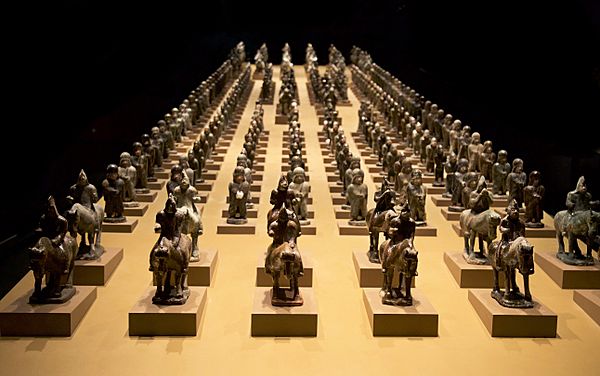
War began even before Northern Wei unified the north. Emperor Wu of Liu Song, a general at the time, had expanded Jin territory. After he became emperor of the Song dynasty, the Wei emperor Mingyuan invaded in 422 CE. Wei aimed to capture cities south of the Yellow River.
Many cities fell to the Wei army. However, the Liu Song general Tan Daoji managed to defend some areas. Wei forces had to retreat when their food supplies ran out. Wei also captured Luoyang and Xuchang, cutting off Song's relief forces. In 423 CE, Hulao fell, and Northern Wei controlled much of modern Henan and western Shandong.
Emperor Wen of Liu Song continued his father's campaigns. In 430 CE, Liu Song regained four cities south of the Yellow River. But Emperor Wen's decision not to advance further led to the destruction of their ally, Xia, by Wei. This mistake was repeated, and Wei unified the North in 439 CE.
In 450 CE, Emperor Wen launched a huge invasion to destroy Northern Wei. It started well but became a disaster. Wei forces tricked Liu Song into crossing the Yellow River, then attacked them from the sides.
As Liu Song armies retreated, Emperor Taiwu of Wei ordered his troops south. Wei armies devastated the provinces south of the Yellow River. Only the fortified city of Huatai held out. Wei troops retreated in 451 CE, but the damage to Song was huge. Emperor Wen tried again in 452 CE but failed. He was then killed by his son.
In 466 CE, a civil war in Liu Song led to some territories surrendering to Northern Wei. Northern Wei quickly defended these new lands. Liu Song forces failed to retake them, and these populated areas were lost to Northern Wei in 467 CE.
Battles with Southern Qi
In 479 CE, Xiao Daocheng took over the Liu Song throne and started the new Southern Qi dynasty. Northern Wei decided to invade, claiming they wanted to put a Liu Song prince back on the throne.
Wei troops attacked Shouyang but could not capture it. Southern Qi strengthened its capital, Jiankang, to prevent more raids. Many small battles and sieges happened until 481 CE. A peace treaty was signed in 490 CE with Emperor Wu.
Battles with Liang
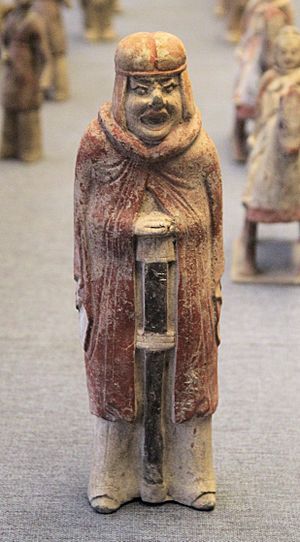
In 502 CE, the Southern Qi general Xiao Yan overthrew the emperor and became Emperor Wu of the Liang dynasty.
In 503 CE, Northern Wei tried to restore the Southern Qi throne. They planned to install Xiao Baoyin, a Southern Qi prince, as a puppet ruler. Wei forces captured Xinyang and Hanzhong by 505 CE.
In 505 CE, Emperor Wu of Liang started his own attack. His general Wei Rui quickly gathered a strong army. In 506 CE, Wei Rui captured Hefei. Later, the Liang commander, Xiao Hong, fled in fear, causing his army to collapse. Northern Wei then attacked Zhongli but were defeated by Wei Rui and Cao Jingzong. This battle effectively ended the large-scale war.
In 524 CE, while Northern Wei was dealing with rebellions, Emperor Wu of Liang launched more attacks. Liang forces met little resistance. In 525 CE, a Northern Wei general surrendered the key city of Pengcheng to Liang. However, Emperor Wu's son, Xiao Zong, suspected he was not Emperor Wu's real son. He surrendered Pengcheng back to Northern Wei, ending Liang's advances in the northeast. Liang continued to gain small territories on the borders.
In 528 CE, after a coup in Northern Wei, many officials fled to Liang. Emperor Wu of Liang supported Yuan Hao, a Northern Wei prince, to claim the throne. General Chen Qingzhi led a small army to escort Yuan Hao. Despite its size, Chen's army won many battles. In 529 CE, Yuan Hao declared himself emperor of Northern Wei after capturing Luoyang. However, Yuan Hao secretly wanted to betray Liang. Soon, the Northern Wei general Erzhu Rong counterattacked, and Luoyang fell. Yuan Hao was killed, and Chen's army was destroyed.
Emperor Wu made another attempt in 530 CE to set up a puppet ruler in Northern Wei, but it failed. In 532 CE, he tried again, but the new emperor, Emperor Xiaowu, had Yuan Yue executed.
When Northern Wei split into Eastern and Western Wei, Emperor Wu continued to gain small territories on the borders for several years.
Important Policies and Reforms
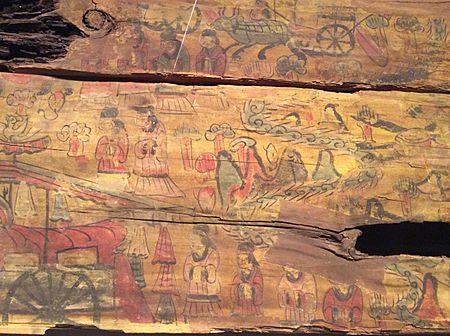
Early in its history, the Northern Wei kept some unique customs from its Xianbei tribal past. These included:
- Officials did not receive regular salaries. They were expected to take what they needed directly from the people they governed. This often led to corruption. Later, the state started paying salaries.
- To become empress, a candidate had to successfully forge a golden statue. This was seen as a sign of divine favor.
- All men had to tie their hair into a single braid, rolled on top of their head, and wear a cap.
- When a new crown prince was chosen, his mother, if still alive, was often forced to take her own life. This was believed to be a custom started by the first emperor, Emperor Daowu of Northern Wei, to prevent mothers from interfering in politics.
- Because emperors often didn't have mothers, they honored their wet nurses with a special title, "Nurse Empress Dowager."
As the Northern Wei adopted more Han Chinese ways, these old customs slowly disappeared.
After building a Chinese-style capital, Tuoba Gui worked to reduce the power of the tribes. He reorganized people into eight new tribes, settled them around the capital, and removed traditional tribal leaders. These changes helped shift loyalty from tribes to the dynasty. These tribes also formed the emperor's personal army, which helped keep the dynasty strong.
Empress Dowager Feng's Reforms
After making sure the Xianbei had control over China, Empress Dowager Feng (438-490 CE) introduced major reforms in 485-486 CE. These changes greatly strengthened the empire's finances and its control over local society.
Two key policies were the "equal-field landholding system" and the "three-elder system."
- Equal-field system: In 485 CE, the state gave out unused land to common people. In return, they had to pay taxes in grain, cloth, and labor. Each household received land based on how many workers it had. For example, an adult male received 40 mu (a unit of land) for crops. Some land was for growing mulberry trees (for silk) or hemp, and this land could be inherited. Households with slaves or oxen received more land. Selling land grants was forbidden.
- Three-elder system: Started in 486 CE, this system helped the government keep accurate records of people and manage villages. Five households formed a neighborhood, led by a neighborhood elder. Five neighborhoods formed a village, led by a village elder. And five villages formed a ward, led by a ward elder. These elders were appointed by the government. They were responsible for finding unregistered people, collecting taxes, and helping the poor. This system greatly increased the state's control over its people.
Empress Dowager Feng's reforms boosted farming and tax collection. They also reduced the power of local nobles who had been hiding people from taxes. After these reforms, the Northern Wei dynasty's registered population doubled to over 5 million households.
These important systems created by the Northern Wei lasted even after the dynasty fell. They helped prepare China for its reunification under the Sui dynasty in 589 CE.
Later Reforms and Deportations
The Northern Wei used the "Nine-rank system" from earlier dynasties. This system assigned official positions to wealthy Han Chinese families based on their family's status. Officials also had a lot of freedom, like appointing their own assistants.
During the reign of Emperor Daowu of Northern Wei (386–409 CE), many people were moved from conquered areas to Datong. For example, about 460,000 people from the former Later Yan territory were moved. These forced movements often happened after new land was conquered.
| Year | People Moved | Number | Destination |
|---|---|---|---|
| 398 | Xianbei from Hebei and Northern Shandong | 100,000 | Datong |
| 399 | Important Chinese families | 2,000 families | Datong |
| 399 | Chinese farmers from Henan | 100,000 | Shanxi |
| 418 | Xianbei from Hebei | ? | Datong |
| 427 | People from the Kingdom of Xia | 10,000 | Shanxi |
| 432 | People from Liaoning | 30,000 families | Hebei |
| 435 | People from Shaanxi and Gansu | ? | Datong |
| 445 | Chinese farmers from Henan and Shandong | ? | North of Yellow River |
| 449 | Craftsmen from Chang'an | 2,000 families | Datong |
Adopting Chinese Culture (Sinicization)
As the Northern Wei empire grew, its emperors wanted to adopt more Han Chinese ways and have Chinese advisors. Cui Hao (381–450 CE), an advisor in Datong, played a big role in this. He brought in Chinese ways of governing and Chinese laws. He also helped establish a Taoist religious system that lasted until 450 CE. Chinese goods, the royal court's love for luxury, and the high status of Chinese culture all increased Chinese influence in Northern Wei.
This influence grew even faster when the capital moved to Luoyang in 494 CE. Emperor Xiaowen continued this by making it a policy to systematically adopt Chinese culture, and his successors followed. Xianbei traditions were largely given up. The royal family even changed their last name to Yuan to become more Chinese. Marriages between Xianbei and Chinese families were encouraged.
With these changes, Buddhist temples appeared everywhere, replacing Taoism as the main religion. These temples were often very grand and beautiful. From 460 CE onwards, emperors also built huge Buddha statues near their capital Pingcheng. These statues declared the emperors as representatives of the Buddha and rightful rulers of China.
The Northern Wei began arranging marriages between their royal Tuoba Xianbei family and important Han Chinese families in the 480s CE. More than half of the Tuoba Xianbei princesses married Han Chinese men from southern China's imperial and noble families who had moved north. Some Han Chinese royal refugees also fled from southern China and joined the Xianbei. For example, several daughters of Emperor Xiaowen of Northern Wei married Han Chinese elites.
When the Eastern Jin dynasty ended, Northern Wei welcomed the Han Chinese Jin prince Sima Chuzhi as a refugee. A Northern Wei princess married Sima Chuzhi, and they had a son named Sima Jinlong. The daughter of the Northern Liang Xiongnu King Juqu Mujian later married Sima Jinlong.
The Northern Wei had eight noble Xianbei family names: Buliugu, Helai, Dugu, Helou, Huniu, Qiumu, Gexi, and Yuchi. They all adopted Chinese last names.
Confucius was honored with sacrifices by the northern dynasties, even those of non-Han origin. For example, the Murong Wei Former Yan Xianbei leader, the Di ruler Fu Jian (337–385), and the Northern Wei Xianbei dynasty all honored Confucius. Emperor Mingyuan, Tuoba Si, honored Confucius, as well as Han dynasty emperors, the Shang dynasty ruler Bigan, Emperor Yao, and Emperor Shun. Emperor Xiaowen, Tuoba Hong, honored Confucius extensively.
A descendant of Confucius was given a noble rank and land in 495 CE. A descendant of Yan Hui, Confucius's favorite student, also received honors.
Some groups, like the Celestial Masters under Kou Qianzhi and Cui Hao, tried to persecute Buddhists under Emperor Taiwu. They argued that Buddhism was harmful to stability and family. However, their anti-Buddhist campaign did not fully succeed.
Building the Great Wall
To protect against threats from the Rourans, Northern Wei emperors started building their own Great Wall. This was the first major wall construction since the Han dynasty. In 423 CE, a defense line over 2,000 li (about 1080 km) long was built. Its path generally followed the old Zhao wall. In 446 CE, 100,000 men built an inner wall. These two Northern Wei walls formed the basis of a double-layered defense system that protected Beijing a thousand years later during the Ming dynasty.
Internal Problems and Breakup
The decline of Northern Wei began with rebellions in the Six Garrisons. These garrisons were military towns on the northern border, set up to protect against the Rouran. They were made up of various ethnic groups, including Xianbei, Gaoche, Xiongnu, and Han Chinese. The rebellions started because of conflicts between the upper-class military leaders and the lower-class soldiers and settlers. The leaders, often Xianbei nobles or Han strongmen, sometimes favored their own groups. This led to unfair policies, especially in areas with harsh conditions and limited resources. The main cause of these wars was the growing difference between the ruling class, who were adopting Chinese ways, and their nomadic armies, who wanted to keep their traditional lifestyle.
Rebellions in the Frontier Towns
Rebellions broke out in six major garrison-towns on the northern border. These spread quickly across the north and lasted for about ten years.
In 523 CE, the Rouran tribes faced a severe famine. In April, the Rouran Khan sent troops to raid Wei territory. People in the town of Woye rose up and killed their commander. Poliuhan Baling became a rebel leader, and his army quickly took Woye.
Elsewhere, in Qinzhou, Qiang leaders like Mozhe Dati also rebelled. In Gaoping, Hu Chen and the Xiongnu rebelled, with Hu Chen calling himself the King of Gaoping. In Hebei, Ge Rong rebelled and declared himself the Emperor of Qi.
The Poliuhan Baling rebellion was defeated in 525 CE. Other similar rebellions in Hebei and Guanzhong were stopped by 530 CE.
Rise of Erzhu Rong and the Heyin Incident
The situation worsened when Empress Dowager Hu and her son, Emperor Xiaoming, had a serious disagreement about who should rule. This led to a tragic event where Emperor Xiaoming died in 528 CE. Upon hearing this, the general Erzhu Rong, who had been secretly ordered by the emperor to help him, marched towards Luoyang.
Erzhu Rong announced he would install a new emperor. He gathered city officials to meet the new ruler. However, he told them they would be punished for misgoverning. He then killed many of them, throwing Empress Hu and her chosen child emperor into the Yellow River. Reports say about 2,000 officials were killed in this Heyin incident on May 17, 528 CE. Erzhu Rong then made Yuan Ziyou, a grandson of Emperor Xianwen, the new emperor, known as Emperor Xiaozhuang of Northern Wei.
In 529 CE, the Liang general Chen Qingzhi attacked Luoyang. Emperor Xiaozhuang was forced to flee. Chen Qingzhi then supported another prince, Yuan Hao, as emperor. However, Erzhu Rong eventually defeated Chen Qingzhi.
Civil War and Two Generals
After this, the Erzhu family controlled the imperial court. The emperor had power only in name. Most decisions were made by the Erzhus. Emperor Xiaozhuang, however, did not want to remain a puppet ruler. He was very wary of the Erzhu family's power and loyalty. In 530 CE, Emperor Xiaozhuang killed Erzhu Rong in an ambush at the palace. This led to more civil war, first between the Erzhu clan and Emperor Xiaozhuang. After defeating Emperor Xiaozhuang in 531 CE, the Erzhu clan then fought against those who resisted their rule.
After these wars, two generals took actions that would split the Northern Wei into Eastern and Western Wei.
General Gao Huan was a soldier from the northern frontier. He had surrendered to Erzhu and became one of Erzhu's top assistants. But later, Gao Huan gathered his own troops, both Han and non-Han, to fight against the Erzhu clan. He entered and took the capital Luoyang in 532 CE. Gao Huan removed the emperor supported by the Erzhu clan, as well as an emperor he had previously supported. He then placed a new emperor, Emperor Xiaowu of Northern Wei, on the Luoyang throne.
However, Emperor Xiaowu and the military head of Luoyang, Husi Chun, began to plot against Gao Huan. Gao Huan managed to keep control of Luoyang. The emperor and a few followers fled west to the region ruled by the powerful warlord Yuwen Tai. Gao Huan then decided to move the Luoyang court to his capital city of Ye. This forced 400,000 families (about 2 million people) to leave their homes and move to Ye.
Now, there were two rival claims to the Northern Wei throne. This led to the state splitting in 534–535 CE into the Eastern Wei and Western Wei. The Eastern Wei was initially stronger and seemed likely to quickly defeat Western Wei. However, they were defeated at the Battle of Shayuan in 537 CE, confirming the split of the Northern Wei.
The Fall of Northern Wei
Neither the Eastern Wei nor the Western Wei lasted very long. In 550 CE, Gao Huan's son Gao Yang forced Emperor Xiaojing of Eastern Wei to give up his throne. This ended Eastern Wei and established the Northern Qi dynasty. Similarly, in 557 CE, Yuwen Tai's nephew Yuwen Hu forced Emperor Gong of Western Wei to give up his throne to Yuwen Tai's son Yuwen Jue. This ended Western Wei and established the Northern Zhou dynasty. In 581 CE, the Northern Zhou official Yang Jian had the emperor give up his throne to him, establishing the Sui dynasty.
Legacy and Culture
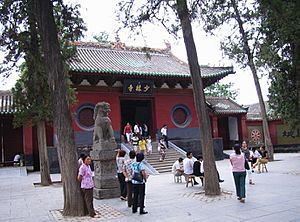
The Northern Wei dynasty was the longest-lasting and most powerful of the northern dynasties before China was reunified by the Sui dynasty. Its most important legacy was the major reforms introduced by Empress Dowager Feng and continued by her successors. Even though the dynasty officially ended in 557 CE, these reforms, especially the equal-field landholding system, lasted until the mid-eighth century CE.
These reforms completely changed China's political development. They reversed trends like power going to local strongmen and political fragmentation. Historians generally believe the Northern Wei dynasty laid the groundwork for China's eventual reunification under the Sui dynasty. For example, historian Ray Huang noted that these reforms created the "infrastructure of a regenerated empire." New rulers after Northern Wei, like Yang Jian of the Sui dynasty, inherited the agricultural resources and manpower made available by these reforms to reunify all of China.
Many important Chinese heritage sites were built by the Northern Wei. These include the Yungang Grottoes, the Longmen Caves, the Shaolin Monastery, and the Songyue Pagoda. Important books like Qimin Yaoshu (a book on agriculture) and Commentary on the Water Classic (a huge work on China's geography) were written during this era.
The legend of Hua Mulan comes from the Northern Wei era. In this story, Mulan disguises herself as a man to take her aged father's place in the Wei army to defend China from Rouran invaders.
Central Asian Influences
Northern Wei art was influenced by Indian and Central Asian traditions through trade routes. A Central Asian (胡) named An Ton, a descendant of the Parthian missionary An Shigao, was an advisor to the first Northern Wei emperor Tuoba Gui (370-409 CE). Most importantly for Chinese art history, the Wei rulers became Buddhists and greatly supported Buddhist art.
Many Central Asian objects have been found in Northern Wei tombs, like the tomb of Feng Hetu. It is believed that many Western objects came to the Northern Wei after they defeated the Rouran around 450 CE. This allowed diplomatic and merchant caravans from Khotan, Kashmir, and Sasanian Persia to visit.
Also, when the Northern Wei defeated the Northern Liang in 439 CE, they captured many Sogdian merchants from their capital Wuwei. They resettled these merchants in their own capital at Datong, which helped boost trade.
Sovereigns of the Northern Wei Dynasty
| Posthumous name | Personal name | Period of reign | Era names |
|---|---|---|---|
| Daowu | Tuoba Gui | 386–409 | Dengguo (登國) 386–396 Huangshi (皇始) 396–398 Tianxing (天興) 398–404 Tianci (天賜) 404–409 |
| Mingyuan | Tuoba Si | 409–423 | Yongxing (永興) 409–413 Shenrui (神瑞) 414–416 Taichang (泰常) 416–423 |
| Taiwu | Tuoba Tao | 424–452 | Shiguang (始光) 424–428 Shenjia (神䴥) 428–431 Yanhe (延和) 432–434 Taiyan (太延) 435–440 Taipingzhenjun (太平真君) 440–451 Zhengping (正平) 451–452 |
| – | Tuoba Yu | 452 | Chengping (承平) 452 |
| Wencheng | Tuoba Jun | 452–465 | Xing'an (興安) 452–454 Xingguang (興光) 454–455 Tai'an (太安) 455–459 Heping (和平) 460–465 |
| Xianwen | Tuoba Hong | 466–471 | Tian'an (天安) 466–467 Huangxing (皇興) 467–471 |
| Xiaowen | Tuoba Hong Yuan Hong |
471–499 | Yanxing (延興) 471–476 Chengming (承明) 476 Taihe (太和) 477–499 |
| Xuanwu | Yuan Ke | 499–515 | Jingming (景明) 500–503 Zhengshi (正始) 504–508 Yongping (永平) 508–512 Yanchang (延昌) 512–515 |
| Xiaoming | Yuan Xu | 516–528 | Xiping (熙平) 516–518 Shengui (神龜) 518–520 Zhengguang (正光) 520–525 Xiaochang (孝昌) 525–527 Wutai (武泰) 528 |
| – | Yuan Zhao | 528 | – |
| Xiaozhuang | Yuan Ziyou | 528–530 | Jianyi (建義) 528 Yongan (永安) 528–530 |
| – | Yuan Ye | 530–531 | Jianming (建明) 530–531 |
| Jiemin | Yuan Gong | 531–532 | Putai (普泰) 531–532 |
| – | Yuan Lang | 531–532 | Zhongxing (中興) 531–532 |
| Xiaowu | Yuan Xiu | 532–535 | Taichang (太昌) 532 Yongxing (永興) 532 Yongxi (永熙) 532–535 |
Images for kids
-
Gilt silver from Bactria (5th c.), Northern Wei tomb.
-
A Buddhist stela from the Northern Wei period, built in the early sixth century.
See also
 In Spanish: Dinastía Wei del Norte para niños
In Spanish: Dinastía Wei del Norte para niños



